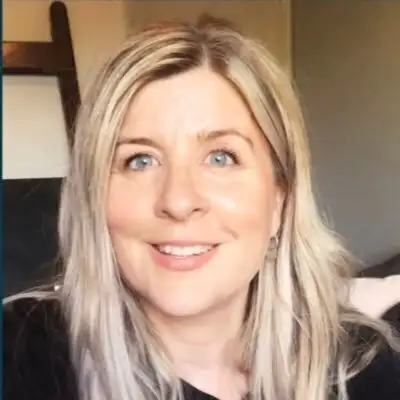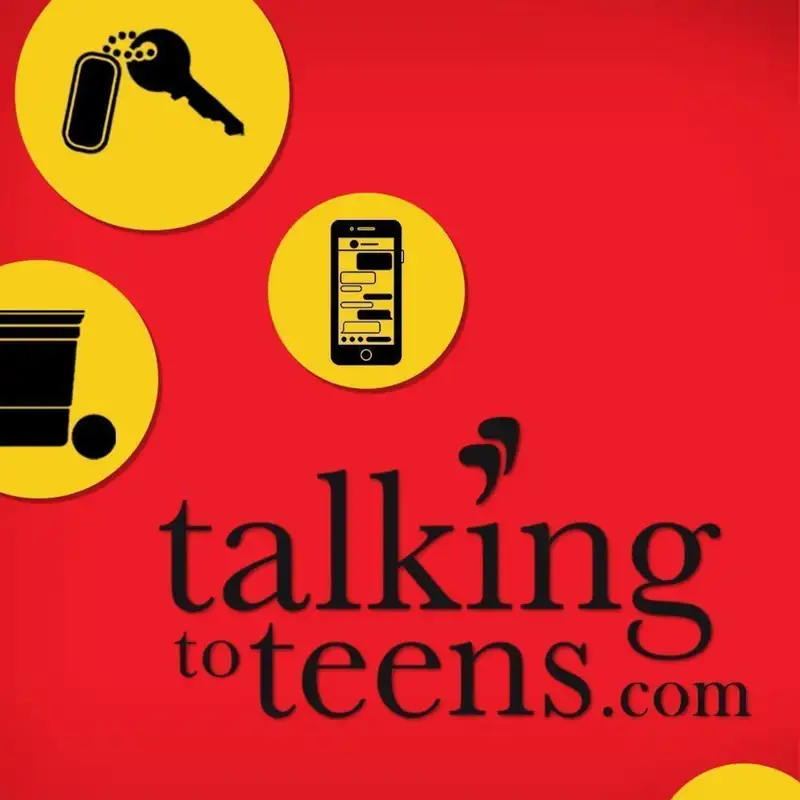Ep 10: Help Teens Cope with Anxiety
Karen: Well, it's nice to speak to you. I love your website.
Andy: Well, thank you. Likewise.
Karen: You're doing great stuff.
Andy: Okay. So I feel like a fun place to start is your website, which is how I found you. And I was just curious how it came about. I mean, it looks like something that you've been doing for a while. What were you in before that? What inspired you to, "Hey, I'm going to start a blog," and how did it grow to be such a big thing?
Karen: So I think it's just a collision of beautiful coincidences as these things often are, but I was a psychologist and I did that for a long time, and then I left for a few years to stay at home with my children. And then when I was ready to go back, I wasn't sure what I wanted that to look like. So I was at a bit of a loss and a little bit... I was lost for maybe eight to ten months just wondering what to do. I didn't know what I wanted to do. And it was actually on a driving holiday with my husband, and he actually said, "Why don't you do something with the internet?" And I said to him, "Psychology on the internet? That's so ridiculous. You just know nothing about this."
Karen: And so we kept talking, and as we kept talking, I thought, "You know what? I think I'm just going to start," because I didn't know what else to do. I just want to put the information out there. I just want people to know what we know as psychologists and therapists and educators. I just want them to know, because if you look at children or teens, which is what we're talking about today, the parents are the most powerful people in their lives. So when they have this information, they do really great things and that's what I'm seeing. So it's important, because I get emails from teens as well about things like anxiety, and they think they're the only ones. And I go, look at all the comments on this page. You're not. You're so not. You're becoming more in the majority than you think.
Karen: I still write about general things. I still write about everything about what I've discovered is anxiety, from my website anyway. There's just such a need for information. And I think the thing about anxiety is we all experience it on some level. We all do. Some more than other people, and for some people it intrudes more than others and at different times in their lives. My daughter was moving from junior school to middle school across the road, same school. She loved school. She loved her friends. But she was getting headaches and tummy aches and not sleeping well. And I thought, "Oh..." It actually took me a couple of weeks to go, "Oh, I know what's going on there." And so we had a talk about what anxiety is and what it does and why she feels this way.
Karen: Because I think the most confusing thing about anxiety is, why does my tummy feel sick? If there's nothing to worry about, why do I worry? If everything's okay, why do I feel panicky? Why are my muscles wobbly? Why is this happening? And it's scary. And you can get anxiety about the anxiety. And it was on the way to soccer, she said, "Mom, I've got that feeling again." And I said, "Does it feel like that feeling you get when you miss a stair?" And she said, "That's exactly what it feels like." She actually said, "It's that feeling you get when you're falling asleep and you jump awake." And I said, "You've got this thing called anxiety, and everybody gets it, and some people get it more than others."
Karen: And we had this... It was honestly a 15-minute conversation. And it was about what the symptoms are for. Because every symptom with anxiety has a really good job to do. Anxiety, like everything with us humans, everything happens for a reason, but sometimes it happens too much or too unnecessarily. And that's what was happening. So I explained it. When you get a tummy ache, this is what happens. And when you feel like you're going to be sick, this is why, and the butterflies over here. And I said, "And this is what you have to do to feel better."
Karen: Because once I think people understand what's happening, the response makes more sense. So I think it doesn't work as well to say to people, "You need to exercise and that'll help your anxiety or your depression," without explaining how that works. And it wouldn't work for me either. If someone said, "Well, you've got to exercise to help your anxiety and depression," I'd go, "I don't get it." I do, but you need that middle ground and then it all makes sense. And about two weeks later, she said, "Mom, that chat we had really helped. I haven't had that thing." And she's still got it sometimes. So then I wrote about it and basically the post was explaining what happens in the brain during anxiety and what happens in our body and why breathing works, why exercise works. So it's that middle scaffold, I suppose.
Andy: I love what you're saying. And I feel like too often as parents, we try to figure out what's the solution. And this idea that part of the solution might be to not just jump straight to looking for solutions, but to give them the information about what's going on and why. And I keep thinking about Robert Sapolsky when you're saying this. He's a Stanford neuroscientist and he does a lot of stuff about stress. And he's big on this idea that we have this stress system that evolved for running away from a tiger, and fight or flight, life and death situations, and it works really well for that, but that the problem of course is now here, we find ourselves in this new type of society where someone posting something on social media can trigger it, or a test at school today.
Andy: And so we're overly triggering this stress system. And you talked about how talking through the specific symptoms with your daughter. So did you then ask her about the symptoms that she was feeling and then explain specifically each thing that she talked about and how that would have been adaptive in evolutionary history? Can you walk me through that a little bit? I mean, because if you're a parent and you don't know psychology, that might be a little harder. How would you recommend approaching a conversation like that?
Karen: Okay. So the thing that kids need to understand first is exactly what you just said. Anxiety is actually there to help us. It's an early warning signal that there might be trouble that we need to get ourselves into position to deal with. Now, the thing with that is it's evolved and it's evolutionary, as everything in our human system is. It started to get us away from physical threats because they were the only threats that faced us way back then. The problem now is the threats are generally psychological. So when there is a physical threat, if there's a basketball coming at our head, anxiety is great because what it does is it surges us with a cocktail of chemicals, which are all good and all normal and all healthy, to get us physiologically ready for action. So once kids understand that it starts to make sense.
Karen: Now, if it's anxiety around an exam or kids at school, or "But what if something happens to you while I'm away from you?" which is separation anxiety, there's no physical response needed there. Now what happens then is the chemicals build up. And that's when the symptoms of anxiety happen, because the idea was meant to be that these chemicals, when we flee or fight, they get burnt off through activity. So when our brain surges with these neurochemicals, our heart beats faster, that's the first thing that happens, and that's to get them around our body effectively. We start to take short, shallow breaths instead of normal, steady breathing. And that's because we want to conserve oxygen and energy in case we have to fight or flight.
Karen: Any process that isn't absolutely essential in the moment shuts down. Not completely, but it just softens, because our body's going, "You're going to need everything you need to fight or flee." One of those processes is digestion. Now that's why you can get a dry mouth. That's why you can get butterflies in the tummy or feel sick. Also the short sharp breathing can make us sick as well. The fuel gets sent to our arms so they can fight and our legs so they can flee, which is why we get tense or wobbly. And people will feel the... For me, it's wobbly when I'm anxious. And that's just a build up of the neuro-chemical, because when you're standing there, you're not burning them. You're not burning them fighting or fleeing. Our body starts to cool itself in case we fight or flee, so it doesn't overheat, and the way the body cools itself is by sweating. So that's why you can be in an exam in an air conditioned room and sweating like a Trojan. That's just the body going, "Well, you're going to actually start gearing up for some action, so we'd better make sure you don't overheat."
Karen: What happens, those physical symptoms can feel so scary, and those physical symptoms in themselves can make you anxious. So that feeds into the "There must be something bad about to happen," which then feeds back into the symptoms. So it's a bit of a loop. So what we have to explain to kids is these physical symptoms aren't because something's about to happen. Your brain thinks something's about to happen. And I wrote a book for kids and it's called Hey Warrior, because that part of your brain, the amygdala, which starts the anxiety response, is like a fierce warrior there to protect you. It's a good thing. It's there to look after us. So anxiety is actually there to look after us, even though it feels awful.
Karen: So what you want to do is be the boss of your brain and not let your brain decide when there's threat, because that's all it's doing. It's going, "Whoa, that might hurt you. That might hurt you. We better get you ready." And it's running amok, which is absolutely fine and it's a strong, healthy brain. There's nothing wrong with it. But you've got to be the boss of it. And so that's where things like mindfulness and exercise and understanding... So once kids understand what anxiety is and what those physical symptoms are and switch them off, because the very first thing that happens when you're anxious is your breathing changes. And that contributes to this cascade of this physiological response. When you get your breathing under control, that starts to neutralize those neurochemicals. It initiates the relaxation response, which we know starts our brainwaves into a pattern which is more consistent with relaxation. It neutralizes the neurochemicals. We start to feel okay. It's really hard to remember slow, steady breathing in the midst of anxiety, because your brain is really busy protecting you. It's like, "Don't tell me, don't. I don't need..."
Karen: So they need to practice it out of anxiety. And if you tell someone who's in the middle of anxiety to breathe strong, steady breaths, they probably won't. They won't be able to. And it might even make it worse because you're asking them to do something they can't do, and they don't understand why they have to. So the idea for teens and for kids, for all of us, is to practice strong, steady breathing so it becomes an automatic response for the brain. So a couple of minutes a day, because the brain learns through experience. The more you do something, the more those neural connections fire up and make that response easier to access.
Karen: The other thing that happens, actually, during anxiety, I think this is really important for teens, is when you're anxious, the prefrontal cortex also gets a little bit sent offline. So the prefrontal cortex is the part of the brain that is the thinking part of the brain, and it's there to analyze and think of consequences. And it's the logical reasoning. It's the more evolved part of the brain. The amygdala at the back is very instinctive and very primitive. So in an exam, I mean, I hear teens a lot go, "But I knew it all, and I just freaked out and I couldn't think of the answers." That's because when you're anxious, your thinking-brain is offline. It's not there for you.
Karen: So breathing brings it back. Because when that thinking brings back online, and when that connection with the back of the brain is strong, which is what mindfulness does, the prefrontal cortex can actually calm the amygdala. Now, even that is really adaptive because if there's a threat and if it's immediate, if there's immediate danger to your life, your amygdala doesn't want you to think too hard about whether or not it's a threat. And if there's a wild dog coming at you, you don't want to wonder what breed it is and is it friendly and is it cute and does it have an owner. It's like, "Prefrontal cortex, get out."
Andy: Get out of there. Yeah.
Karen: Because I just need to act. And so that's why it sends it offline. Now in an exam, you need your thinking-brain, or in situations.
Andy: Pretty important.
Karen: So breathing brings it back. So it's all adaptive. It's all really healthy and adaptive. But the problem is when it fires up when there is no threat, it can really get in our way.
Andy: So you mentioned a few things in there a couple of times. This idea of being the boss of your brain, I love that. How do you do that? How do you teach your kids how to do that? The other thing you talked about was mindfulness you mentioned a few times. And then the third was breathing that you said a number of times, and I wonder if there's a specific, type of breathing or you just teach them to slow it down and deepen it, or what you recommend for that.
Karen: Okay. So breathing can help you be the boss of the brain because it brings you thinking part online and you can be more in control of your amygdala. So you can be more in control of "No, no, we don't need to fire up now. We're safe and I've got this." So you can actually... "Stand down, amygdala. We're okay. We don't need to fight or flee." It's a bit like that. But the breathing is really just, in for three, hold one, out for three. It's that simple. It's just strong and steady. So what it is, instead of getting into that short, sharp breathing, which changes the balance of oxygen, carbon dioxide, and that contributes to all the physiological things that happen with anxiety. So what we need to do is get that balance back and it's just that steady, strong breathing.
Karen: And there's a few ways. What I did with my daughter, and she's 15 now, so she does it herself now. But if you can imagine a sideways figure 8. And what I would do was at bedtime I would just trace on her arm or her back or wherever she wanted me to. And you'd go. So that would be for three, and then hold it in the middle for one, and then out for three. So she gets into the rhythm because touch is grounding. If they want to be touched. Not all kids want to be touched when they're feeling anxious, but for her... And then what she can do for herself, when she's anxious, she's got that grounding sensation of the sensation of the figure eight. So that's basically... So she can get that rhythm right.
Karen: And the other one is to imagine a cup of hot cocoa, is another one I tell kids and teens. To imagine sniffing in, because you want in, through your nose, out through your mouth, sniffing in for three and imagine this smell and then hold it for one and then blow it cool for three. It's really just basic breathing and it's what we were born to do. But sometimes when our brain gets in the way, and it does, now once that happens and those chemicals start to be neutralized, the prefrontal cortex comes back online. We're back in control of our brain. It doesn't mean you won't feel worried and it's not magic. It doesn't make everything go away, but it means that you can be brave. So you can actually look at things as they are and go, "Okay, I'm going into an exam. I am a bit worried and I am a bit anxious, but I'll be okay and I can do this."
Creators and Guests



